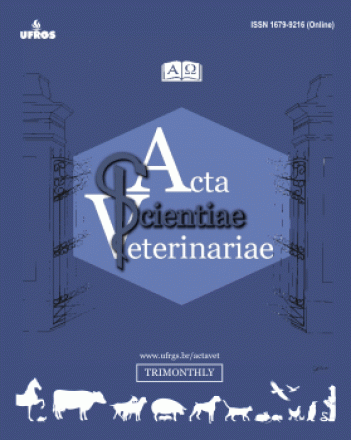Blood or Serum Collected on Filter Paper for Detection of Antibodies to Bovine Herpesvirus Type 1 (BoHV-1)
Acta Scientiae Veterinariae
Blood or Serum Collected on Filter Paper for Detection of Antibodies to Bovine Herpesvirus Type 1 (BoHV-1)
Autor Correspondente: Anna Paula de Oliveira | [email protected]
Palavras-chave: serum neutralization, indirect elisa, bovine herpesvirus, filter paper adsorbed samples
Resumos Cadastrados
Resumo Inglês:
Background: The method of collection as well as the packaging conditions in which samples are submitted to laboratories play
a critical role on the acquisition of reliable results on diagnostic tests. Alternative methods however have been proposed, as the
adsorption of blood or serum in filter paper. In this work, it was evaluated the viability of using serum or whole blood samples
from bovines collected in filter paper for serological testing against bovine herpesvirus type 1 (BoHV-1).
Materials, Methods & Results: One hundred and seven whole blood and serum samples were collected by standard methods.
Serum neutralization test was used as a golden standard method for evaluation of the serum samples. The same samples of both
whole blood and sera were also adsorbed on filter paper strips for further comparisons. Optimal conditions for serum and blood
elution from filter paper were determined. Adsorbed samples on filter paper disks were eluted in PBS and subsequently diluted
further with PBS 5% skimmed milk. The eluates were tested for antibodies to BoHV-1 in an indirect ELISA (iELISA) and matched
with the results obtained by serum neutralization of standard serum samples. Comparison between results obtained by serum
neutralization of standard serum samples and the ones from the iELISA of serum eluted from paper disks resulted in sensitivity,
specificity, positive and negative predictive values of 95, 94, 80, 99%, respectively, and a correlation coefficient (κ) of 0.83.
Comparison between the results of serum neutralization of standard serum samples and the ones from the iELISA of blood eluted
from paper disks resulted in sensitivity, specificity, positive and negative predictive values of 91, 97, 87, 98% , respectively, and
a correlation coefficient (κ) of 0.86. Standard serum samples were also tested in the iELISA and the results compared with those
of iELISA from samples eluted from filter paper. Comparison of the results from iELISA between serum samples and serum eluted
from filter paper resulted in sensitivity, specificity, positive and negative predictive values of 91, 81, 69, 95%, respectively, and a
correlation coefficient (κ) of 0.66. The comparison of iELISA results between standard serum and blood samples eluted from filter
paper resulted, in sensitivity, specificity, positive and negative predictive values of 78, 92, 82, 89%, respectively, and a correlation
coefficient (κ) of 0.70. Fifty samples collected on filter paper were retested eight months later in order to determine whether those
would retain its viability; both sensitivity and specificity remained unaltered.
Discussion: Sampling on filter paper has been successfully described for antibody detection in a number of diseases such as
Aujeszky’s disease virus and Newcastle disease virus. In this work, it has been demonstrated that both blood and sera collected
in filter paper can be used for submission of samples aiming detection of antibodies to BoHV-1 in an iELISA, without significant
loss of sensitivity and specificity. Submission of samples on filter paper is a practical and economical alternative as no special
conditions are required for storaging and transporting. This method also enables the collection of samples from distant places
assuring its quality for serological tests.

